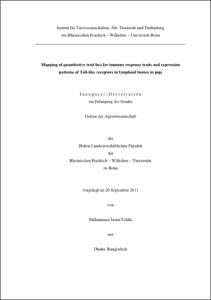Uddin, Muhammad Jasim: Mapping of quantitative trait loci for immune response traits and expression patterns of Toll-like receptors in lymphoid tissues in pigs. - Bonn, 2011. - Dissertation, Rheinische Friedrich-Wilhelms-Universität Bonn.
Online-Ausgabe in bonndoc: https://nbn-resolving.org/urn:nbn:de:hbz:5N-27398
Online-Ausgabe in bonndoc: https://nbn-resolving.org/urn:nbn:de:hbz:5N-27398
@phdthesis{handle:20.500.11811/4761,
urn: https://nbn-resolving.org/urn:nbn:de:hbz:5N-27398,
author = {{Muhammad Jasim Uddin}},
title = {Mapping of quantitative trait loci for immune response traits and expression patterns of Toll-like receptors in lymphoid tissues in pigs},
school = {Rheinische Friedrich-Wilhelms-Universität Bonn},
year = 2011,
month = dec,
note = {The aim of this research was to identify the quantitative trait loci (QTL) affecting antibody and innate immune response traits. For this purpose, Duroc-Pietrain (DUPI) pigs (n = 319) were genotyped with 122 genetic markers and phenotypes of serum antibodies for Mycoplasma hyopneumoniae (Mh) and tetanus toxoid (TT), and interferon-gamma (IFNg) levels were measured following vaccinations (Mh, TT, Porcine Reproductive and Respiratory Syndrome Virus [PRRSV]). Line-cross and imprinting QTL analysis were performed using QTL Express. A total of 30 QTL (12, 6, and 12 QTL for Mh, TT antibody, and IFNg, respectively) were identified, of which 28 QTL were detected by line-cross and 2 QTL by imprinting model. The serum concentration of interleukin 2 (IL2), IL10, IFNg, Toll-like receptor (TLR2) and TLR9 were measured in another group of DUPI population (n = 334) following vaccinations that were genotyped with 82 genetic markers. A total of 33 single QTL were detected, of which eight, twelve and thirteen QTL were identified for immune traits in response to Mh, TT and PRRSV vaccine, respectively. All immune traits are influenced by multiple chromosomal regions implying multiple gene action. Furthermore, expression stability of nine commonly used housekeeping genes (HKG) was studied using qRT-PCR in most lymphoid tissues at different ages (newborn, young and adult) of pigs. This study found that HKG becomes heterogeneous with age and the geometric mean of the RPL4, PPIA and YWHAZ seem to be the most appropriate combination of HKG for accurate normalization of gene expression data in pigs. Moreover, the expression patterns of ten TLRs (1-10) were studied in the same tissues used for HKG study. This study revealed that TLRs mRNA expressions were affected by age and organs. Most of the TLRs expression was higher at young pigs compared to adult and newborn pigs. TLR3 gene was the highest abundant among all TLRs in most tissues. The western blot results of TLR2, 3 and 9 in selected tissues appeared to be consistent with the mRNA expression. The protein localization showed that TLRs expressing cells were abundant in lamina propria, Peyer’s patches in intestine, around and within the lymphoid follicles in the mesenteric and cervical lymph node, within the white pulp in spleen and on the lining cells in bronchioles in lungs. This expressions study first shed light on the expression patterns of all TLR genes in important lymphoid tissues including gut-associated lymphoid tissues in different ages of pigs.},
url = {https://hdl.handle.net/20.500.11811/4761}
}
urn: https://nbn-resolving.org/urn:nbn:de:hbz:5N-27398,
author = {{Muhammad Jasim Uddin}},
title = {Mapping of quantitative trait loci for immune response traits and expression patterns of Toll-like receptors in lymphoid tissues in pigs},
school = {Rheinische Friedrich-Wilhelms-Universität Bonn},
year = 2011,
month = dec,
note = {The aim of this research was to identify the quantitative trait loci (QTL) affecting antibody and innate immune response traits. For this purpose, Duroc-Pietrain (DUPI) pigs (n = 319) were genotyped with 122 genetic markers and phenotypes of serum antibodies for Mycoplasma hyopneumoniae (Mh) and tetanus toxoid (TT), and interferon-gamma (IFNg) levels were measured following vaccinations (Mh, TT, Porcine Reproductive and Respiratory Syndrome Virus [PRRSV]). Line-cross and imprinting QTL analysis were performed using QTL Express. A total of 30 QTL (12, 6, and 12 QTL for Mh, TT antibody, and IFNg, respectively) were identified, of which 28 QTL were detected by line-cross and 2 QTL by imprinting model. The serum concentration of interleukin 2 (IL2), IL10, IFNg, Toll-like receptor (TLR2) and TLR9 were measured in another group of DUPI population (n = 334) following vaccinations that were genotyped with 82 genetic markers. A total of 33 single QTL were detected, of which eight, twelve and thirteen QTL were identified for immune traits in response to Mh, TT and PRRSV vaccine, respectively. All immune traits are influenced by multiple chromosomal regions implying multiple gene action. Furthermore, expression stability of nine commonly used housekeeping genes (HKG) was studied using qRT-PCR in most lymphoid tissues at different ages (newborn, young and adult) of pigs. This study found that HKG becomes heterogeneous with age and the geometric mean of the RPL4, PPIA and YWHAZ seem to be the most appropriate combination of HKG for accurate normalization of gene expression data in pigs. Moreover, the expression patterns of ten TLRs (1-10) were studied in the same tissues used for HKG study. This study revealed that TLRs mRNA expressions were affected by age and organs. Most of the TLRs expression was higher at young pigs compared to adult and newborn pigs. TLR3 gene was the highest abundant among all TLRs in most tissues. The western blot results of TLR2, 3 and 9 in selected tissues appeared to be consistent with the mRNA expression. The protein localization showed that TLRs expressing cells were abundant in lamina propria, Peyer’s patches in intestine, around and within the lymphoid follicles in the mesenteric and cervical lymph node, within the white pulp in spleen and on the lining cells in bronchioles in lungs. This expressions study first shed light on the expression patterns of all TLR genes in important lymphoid tissues including gut-associated lymphoid tissues in different ages of pigs.},
url = {https://hdl.handle.net/20.500.11811/4761}
}






